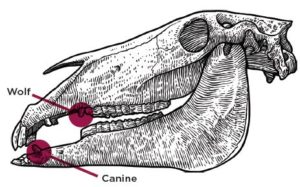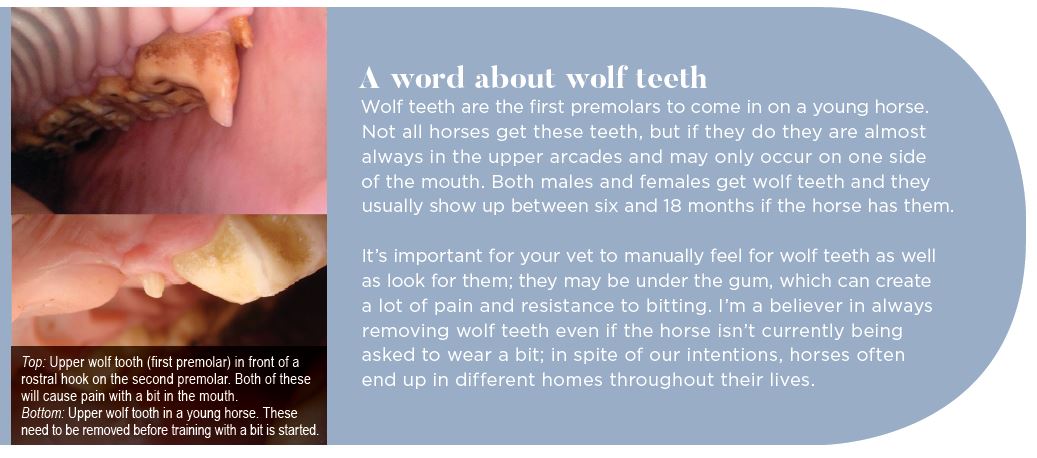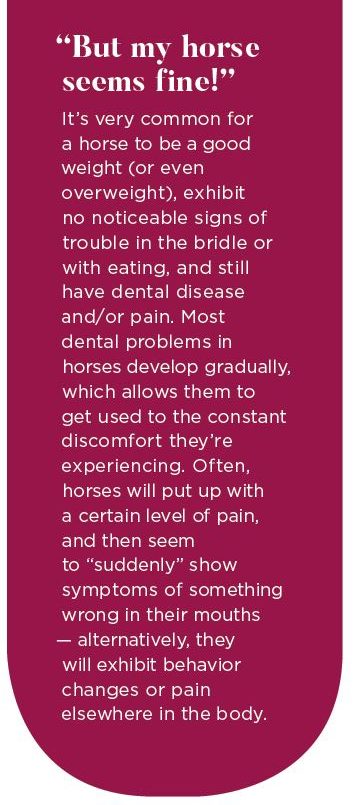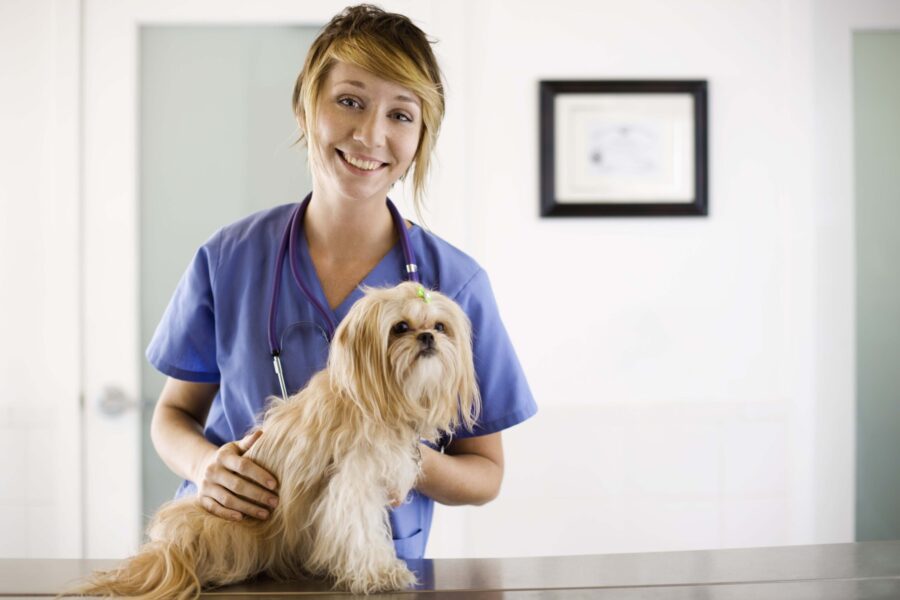Some easy-to-recognize signs that it’s time to schedule a dental appointment for your equine companion.
Ever wonder how often you should get your horse’s teeth checked? This question very much depends on the horse and what will be expected of her by the humans in her life. The general timetable I recommend is:
- One conformation exam between six months and one year of age
- A checkup between 1.5 and 2.5 years to check for wolf teeth and do a “baby float” and equilibration as needed
- Examination and floats every six months between two and five years of age.
After five, a horse should have her teeth checked if it’s been a year since she’s had dental work done, or if it’s been less than a year but she’s exhibiting signs of discomfort or dysfunction when she chews or has a bit in her mouth. Horses in their 20s and 30s may need checkups more often if they have uneven wear or periodontal disease.
 Dental changes through a horse’s lifespan
Dental changes through a horse’s lifespan
Because a horse’s teeth change so quickly in the first five years of his life, it’s best to start early with dental examinations and make a plan based on his individual needs. Any time between six months and a year of age is a great time to have a basic dental conformation exam done by your equine dental-savvy veterinarian. Schedule her in to get her teeth checked every six months until the horse turns five, if possible.
 A pronounced over-jet or under-jet (also referred to as “parrot mouth” or “sow mouth”) to either the incisors or molar arcades should be addressed early on in the growing horse to prevent uneven wear patterns from getting worse as he ages.
A pronounced over-jet or under-jet (also referred to as “parrot mouth” or “sow mouth”) to either the incisors or molar arcades should be addressed early on in the growing horse to prevent uneven wear patterns from getting worse as he ages.
In the first 2.5 years of life, all the teeth in a horse’s mouth are deciduous or “baby” teeth that will be shed and replaced with adult teeth. Typically, this process continues until the horse turns 4.5; they will lose 24 teeth in those two years. The three back teeth in the molar arcades (the true molars) erupt as adult teeth at one, two and three years of age, respectively. These erupting teeth can come in at odd angles since the baby teeth may not come off evenly, and create pain and/or unsymmetrical teeth occlusion.
Erupting canine teeth in male horses (between four and six years of age) are another source of discomfort as the sharp tip of the tooth pushes on the gums for weeks before it erupts. Watch for these bumps between the incisors and molar arcades and be gentle putting the bit in and out to lessen his discomfort during this process. (Note: a touch of clove oil or anbesol liquid on the gums can help ease the pain of erupting canine teeth). The canines are not to be confused with the “wolf teeth”, which are the first premolars (see sidebar above). The canines are unique in that they do not continue to erupt through the horse’s life as the premolars, molars and incisors do. They can, however, get very long and sharp, and reducing their length and smoothing the tips can be beneficial.
It is also important to make sure that young horses don’t have too much floating (grinding/filing) on their teeth at one time. It’s literally impossible to make a float “last” a year in a horse under five years of age, and it is normal for young horses to develop sharp points in between checkups in these early years.
 8 signs it’s time for a dental exam
8 signs it’s time for a dental exam
If you can’t afford regular dental exams for your horse, there are signs you can look for that indicate it’s time to book one.
1. Dropping feed
If whole grain or unchewed balls or ropes of hay (also known as “quids”) fall out of the horse’s mouth after she attempts to chew it, she should have her teeth checked.
2. Weight loss
This is an obvious one that may or may not be related to dental issues but is certainly a reason to have a horse checked. With the right kind of feedstuffs, even horses without any functional teeth can keep weight on, but dental exams and care are important in determining if they are at this stage. An overweight horse can have painful teeth as well so don’t assume a horse is okay just because she isn’t losing weight.
3. Fussing with the bit
Schedule a dental checkup if your horse starts fussing with or refusing the bit, or reacting differently to pressure on the bit.
4. Cranky behavior and head shyness
You don’t have to stick your fingers in your horse’s mouth to see if she has sharp points that are causing discomfort. Generally, you can feel along the cheeks outside where the molar arcades are located; the horse will flinch or pull away when you push her cheek against a sharp tooth.
5. Recent colic or choke
Older horses often lose the ability to chew long stem fiber into small pieces they can adequately digest. But younger horses can also have impaired chewing, and may end up with an esophageal impaction (also known as choke) or colic from improperly chewed masses of hay not moving properly through the gut. Of course, eating too fast or not staying hydrated can also contribute to these problems.
6. Difficulty chewing
If your horse chews differently on one side than the other, or always chews on one side, it could be a sign that her mouth is in pain. This can be challenging to discern but watch which way the lower jaw swings when she’s chewing – you should see it swing out in one direction for a while, then switch to the other direction.
7. Odor from the mouth
I think we can all admit that horses smell pretty amazing! Even their breath is usually sweet and intoxicating. If a horse has a rotten smell coming from her mouth, like sour feed or infected tissue, it’s likely she has an infected or rotten tooth that needs attention. It may also be an indicator that she has feed impacted between her teeth or has developed periodontal pockets. Both of these situations need attention.
 8. Uneven incisors
8. Uneven incisors
Most of the horse’s teeth are hidden from our view and aren’t simple to evaluate on a regular basis. But most people can get a look at a horses front teeth to see if they are lined up. Look at them straight on while someone else holds the horse’s lips apart. Are the teeth in a straight line? Is there a “smile” or “frown” shape to them? Do they have a wedge or diagonal shape, where one side of the upper or lower incisors is much longer than the others? Is the horse missing any front teeth or are there malformed teeth (see image above)?
Horse’s teeth continually erupt from birth to some time in their 20s, at which point they stop erupting and start to wear down. By getting your horse’s teeth checked early on, you can help set them up for better symmetry – and fewer problems – going forward.








